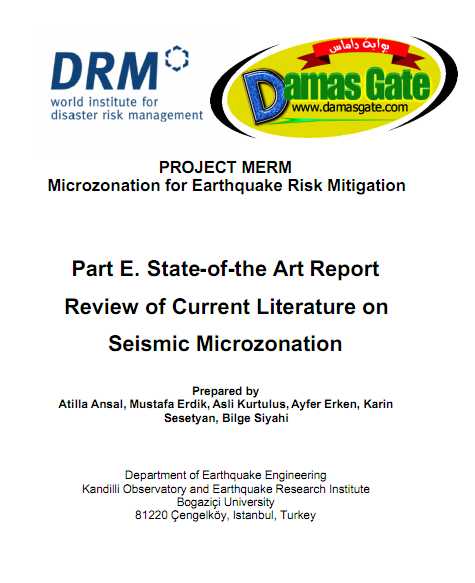Microzonation for Earthquake Risk Mitigation, State of the Art Report

PROJECT MERM Microzonation for Earthquake Risk Mitigation
Part E. State-of-the Art Report Review of Current Literature on
Seismic Microzonation
Prepared by Atilla Ansal, Mustafa Erdik, Asli Kurtulus, Ayfer Erken, Karin
Sesetyan, Bilge Siyahi
Department of Earthquake Engineering Kandilli Observatory and Earthquake Research Institute
Bogaziçi University 81220 Çengelköy, Istanbul, Turkey
1. INTRODUCTION This state -of-the art report has been undertaken within the DRM-MERM Project to define the
primary framework for the Seismic Zonation Manual, under preparation as the main output of this project, with the aim of improving the zonation methodology in Turkey. Thus the review
of the literature has been conducted taking in to consideration the state-of -the-practice in Turkey. Even though significant effort has been made to conduct a thorough review, due to the multi-disciplinary nature of the topic and very large numbers of papers, it would be unrealistic to claim that all the literature on seismic microzonation and related disciplines
have been reviewed. Seismic microzonation can be considered as the preliminary phase of earthquake risk
mitigation studies. It requires multi-disciplinary contributions as well as comprehensive understanding of the effects of earthquake generated ground motions on man made structures (Ansal & Slejko, 2001). Seismic microzonation is evaluation and assessment of different
inputs from different fields of earthquake engineering and engineering seismology. In most general terms, seismic microzonation is the process of estimating the response of soil layers under earthquake excitations and thus the variation of earthquake characteristics on the ground surface. However, it is also very important to select appropriate ground motion parameters for microzonation that correlate with the observed structural damage as well as
that could be implemented in engineering design of the men made structures (Finn, 1991) . The key issue in seismic zonation is how to combine contributions from different fields, what
should be the weights of geological, seismological, geotechnical and structural information with respect to each other and how to issue recommendations suitable for application by local
administrators and practitioners.
Download
http://s18.alxa.net/s18/srvs2/02/001...Art.Report.rar